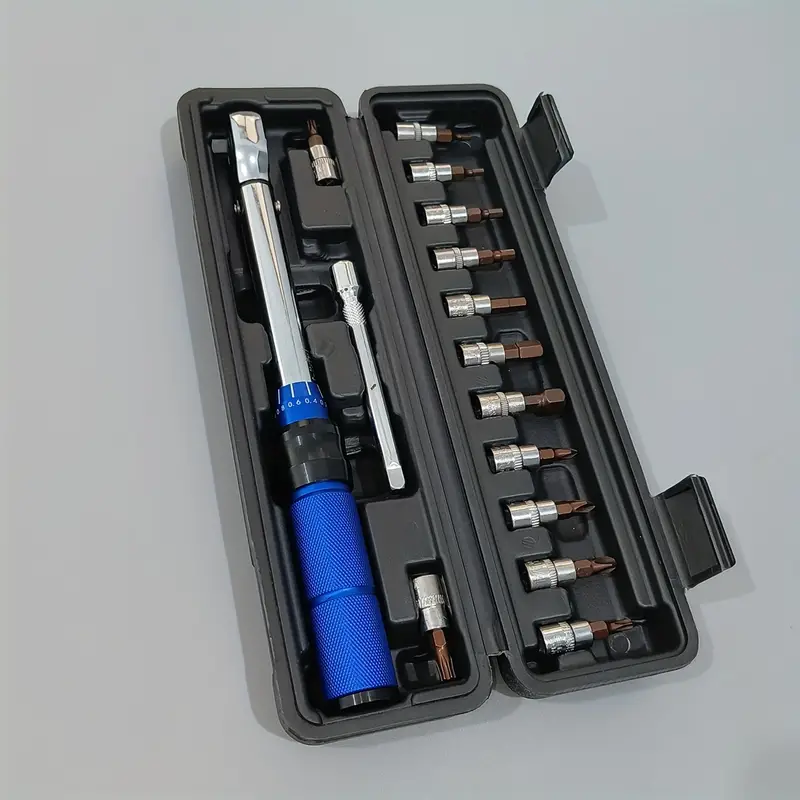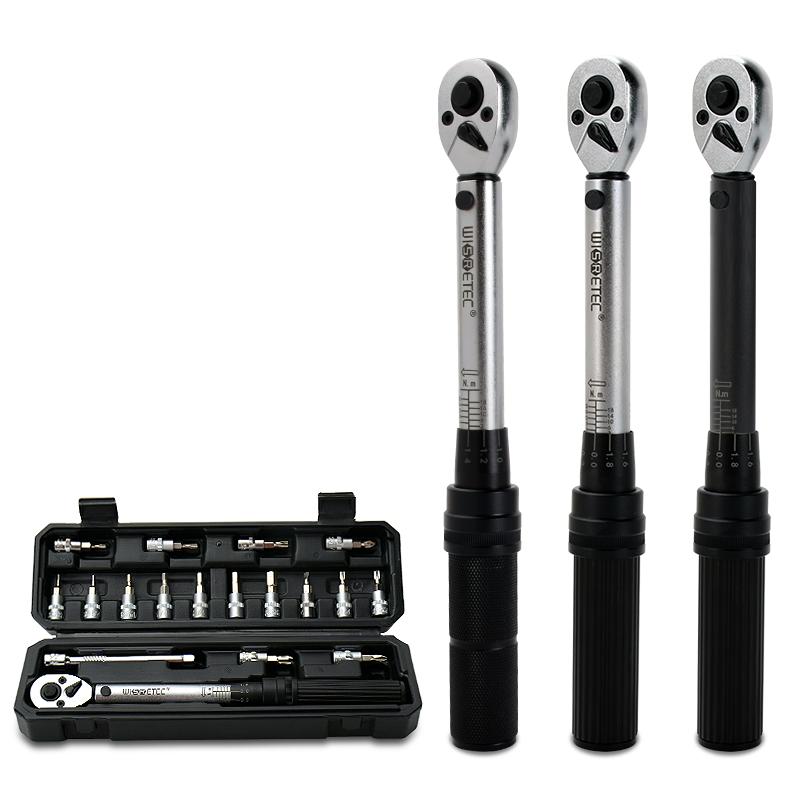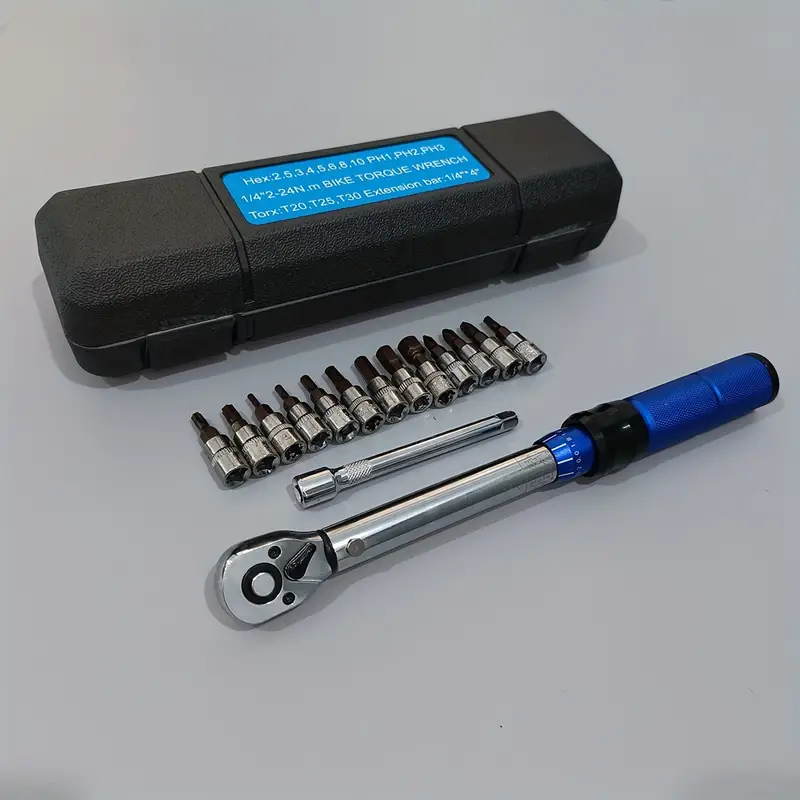Key Considerations Before Buying a Torque Wrench
When exploring the market for a bicycle torque wrench, certain key aspects demand attention. These considerations are pivotal in selecting a wrench that aligns with your cycling needs while offering reliability and ease of use. Here’s a brief guide on making the right choice.
Assess the Torque Range Requirement
Firstly, identify the range of torque values needed for your bike. Bicycle components each have specific torque requirements. Ensure the torque wrench you consider has a range that encompasses these values.
Evaluate Tool Quality
Quality is paramount. A high-quality torque wrench delivers consistent accuracy. This precision is critical for ensuring the safety and longevity of your bike’s parts. Opt for wrenches with a solid reputation for durability.
Check for Included Bits and Adapters
Some torque wrenches come with a set of bits and adapters. Verify if the common sizes for your bicycle, like 3mm, 4mm, 5mm hex keys, and T25 Torx, are included. If not, factor in the cost and availability of these accessories.
Consider the Brand’s Reputation
Well-known brands often mean proven quality and reliability. Read reviews, seek feedback from fellow cyclists, and consider the experiences of users to gauge a brand’s trustworthiness.
Factor in Ease of Use
A torque wrench should be user-friendly. Look for features like a clear display, easy-to-use adjustment mechanisms, and good ergonomics that make routine maintenance straightforward.
Look for Calibration and Certification
A properly calibrated wrench is a must. Check whether the torque wrench has certification for its accuracy and whether calibration services are available, ensuring the tool remains precise over time.
Budget Appropriately
Good tools are an investment. While you may not want to overextend your budget, remember that a low-quality wrench can cost more in the long run due to damage or more frequent calibration needs.
Making a wise choice in a bicycle torque wrench involves balancing these elements to find a tool that will serve you well in the maintenance and care of your bicycle.

The Importance of Torque Wrenches for Bicycle Maintenance
Making sure every component on your bike is secure and properly adjusted is crucial. This not only ensures a safe ride but also improves the longevity of your bike’s parts. Over-tightening bolts can lead to damaged bike parts, while under-tightening may cause components to come loose. Both have potential for serious consequences.
A torque wrench is a specialist tool designed to precisely apply a specific torque to a fastener, such as a nut or bolt. This is especially important for carbon-fiber components, which can easily crack under too much pressure. Equally, sensitive parts like bearings or bolts that hold cable guides in place need careful handling to not compromise their function.
For consistent performance, a bicycle torque wrench is key. It helps maintain your bike at the exact specifications recommended by the manufacturer. With proper torque settings, there’s less risk of wear and tear from vibrations or excess pressure. It’s the difference between estimating and knowing you’ve applied the right amount of torque.
Routine maintenance with a torque wrench can prevent avoidable mechanical failures. It’s an essential tool for both home mechanics and professional workshops. In the long run, it can save time and money that might otherwise be spent on repairs or replacements due to incorrect bolt tension.
Simply put, a quality torque wrench is a must-have for any cyclist dedicated to their bike’s care. It ensures each screw and bolt is tightened to perfection, offering peace of mind and a better riding experience.
Types of Torque Wrenches: Advantages and Disadvantages
When selecting a bicycle torque wrench, understanding the different types is crucial. Each offers unique benefits and limitations, depending on your needs and preferences.
Click-Type Torque Wrenches
Click-type torque wrenches emit a ‘click’ sound when reaching the set torque. They are user-friendly and widely available. However, they require regular calibration to maintain accuracy.
Beam Torque Wrenches
Beam torque wrenches offer a simple design with a visual indicator for torque. They are generally more affordable but lack the precision and convenience of other types.
Electronic Torque Wrenches
Electronic wrenches provide digital readings and can store pre-set torque values. They are highly accurate but rely on batteries and are typically more expensive.
Preset Torque Wrenches
Preset wrenches are set to a specific torque and are ideal for repetitive tasks. While convenient for common torque settings, they offer no adjustability for varied tasks.
Dial Torque Wrenches
Dial torque wrenches have a dial gauge for reading torque values. They are highly accurate and ideal for delicate components but can be challenging to read at certain angles.
Choosing the right type involves weighing these advantages against their disadvantages. Consider your most frequent maintenance tasks and invest in one that suits those needs best. A torque wrench is a tool you’ll often use, so choose one that will stand the test of time and usage.

Understanding Torque Specifications and Measurements
When working on bicycles, understanding torque specifications is crucial for the safety and proper function of your bike. Torque specifications refer to the level of force recommended by the manufacturer when tightening bolts and screws. Abiding by these specifications is paramount, especially for sensitive components. Here’s a comprehensive rundown on the topic of torque specifications and measurements for bicycle maintenance.
Why Torque Specs are Key
Torque specs are not suggestions; they are precise figures derived to ensure optimal performance and safety. Applying the correct amount of torque:
- Prevents damage to lightweight materials, especially carbon fiber.
- Ensures components like handlebars and seatposts are secure, but not over-tightened.
- Reduces the risk of bolts loosening while riding, which can lead to accidents or component failure.
Measuring Torque
Torque is typically measured in Newton meters (Nm) for bicycles. It’s essential to have a torque wrench capable of reading the range needed for bike components, which usually falls between 2 Nm and 20 Nm. Having a wrench that measures accurately within this range is critical for proper bike maintenance.
Adjusting Your Torque Wrench
Adjustable torque wrenches allow you to set the specific torque value required for the task. It’s important to:
- Check the manufacturer’s specifications for the correct torque settings.
- Adjust the wrench to match this value before tightening.
- Return the tool to its lowest setting after use to maintain its calibration.
Learning to Read Torque Wrenches
Understanding how to read your torque wrench ensures you apply the correct force. Different types display this information in unique ways, such as:
- Click-type wrenches emit an audible click when the preset torque is reached.
- Beam types show torque with a visual indicator on a scale.
- Dial types have a gauge to provide an exact measurement.
Importance of Calibration
Regular calibration checks are necessary for precision tools like torque wrenches. Proper calibration ensures accuracy and extends the lifespan of the wrench.
- Send your torque wrench for calibration as per the recommended schedule.
- Always use a calibrated tool to prevent guesswork and to avoid under- or over-tightening.
By fully grasping torque specifications and the proper use of torque wrenches, cyclists and mechanics can guarantee a better functioning and safer bicycle. Stay informed, and your bike will thank you for it.

Features to Look for in a Quality Bicycle Torque Wrench
When you’re choosing a quality bicycle torque wrench, there are several features you should consider. These are essential for ensuring the tool’s effectiveness and longevity. Below are the key attributes that define a quality bicycle torque wrench:
- Precise Calibration: Look for a torque wrench with guaranteed calibration accuracy. This will guarantee precise torque application every time, crucial for delicate parts.
- Durable Construction: A well-constructed wrench promises durability. It should feel sturdy in hand and resist wear over time.
- Clear Scale Display: The torque value scale should be easy to read. For analog wrenches, the markings must be clear. Electronic wrenches should have a bright, readable screen.
- Comfortable Grip: Ergonomics matter. A comfortable grip reduces hand fatigue and improves control when applying torque.
- Ratcheting Head: A ratcheting head allows for easier use in tight spaces. It lets you tighten bolts without repositioning the wrench.
- Torque Range Selection: Ensure the wrench covers the torque range needed for your bike. It should handle the lowest and highest values for bike parts.
- Versatile Bit Selection: A good torque wrench comes with a range of bits. These should cover all common sizes like 3mm, 4mm, 5mm hex, and T25 Torx.
- Easy Torque Adjustment: The method to set torque should be straightforward. This includes simple dialing or digital input, based on the wrench type.
- Audible and/or Tactile Feedback: A clear signal for reaching the set torque is vital. This could be an audible click or a tactile bump.
- Additional Features: Some wrenches feature angle measurement. Others have memory functions or multiple unit readings.
When selecting your tool, match these features against your specific bike maintenance needs. A quality bicycle torque wrench not only aids in precise work but also adds to the joy of bike maintenance.
Adjustability and Range: Why It Matters
When it comes to bicycle maintenance, adjustability and range in a torque wrench are pivotal. Here’s why:
- Adjustability: Different components on your bike need varying torque values. An adjustable torque wrench allows you to set specific torque levels for each part. This ensures both safety and component integrity.
- Wide Torque Range: A broader torque range gives you the flexibility to work on different parts of your bike. From the delicate tightening of a carbon fiber seat post to the more robust requirements of a bottom bracket, one wrench can handle it all with the right range.
- Precision: With adjustability comes precision. By setting the exact required torque, you reduce the risk of over- or under-tightening, which can lead to part failure or damage.
- Convenience: Rather than having multiple tools for different jobs, an adjustable torque wrench streamlines your toolkit. It makes for a more efficient and organized maintenance process.
- Cost-Effective: Investing in a single adjustable torque wrench is often more economical than purchasing several preset tools.
In summary, a torque wrench with adjustable settings and a wide range provides the versatility and precision necessary for proper bike maintenance. It is an essential tool for cyclists of all levels, helping to maintain your bike’s performance and longevity.

Recommended Bicycle Torque Wrench Brands and Models
When looking for a bicycle torque wrench, the market offers a variety of brands and models. Here are some top picks that stand out for their quality and features:
Pedros Demi Torque Wrench II
This model ranks highly for overall reliability. Offering a 3-15Nm torque range, it caters to most bike maintenance needs. It includes eight bits and has a +/- 4% calibration accuracy.
Topeak D-Torq DX
Ideal for tech enthusiasts, this digital torque wrench comes with a wide 4-80Nm torque range. It’s electronic, provides precise readings, and includes twenty bits.
Effetto Mariposa Giustaforza 1-15 Pro Evo
A premium choice, the Giustaforza delivers style with a 1-15Nm torque range. It features a flashy oil-slick finish and dual-direction tightening.
Wera Click Torque A5
For workshop durability, consider the Wera A5. It has a 2.5-25Nm range, a comfortable grip, and adheres to stringent calibration standards.
Feedback Sports Range Click Torque Wrench
Compact and travel-friendly, this wrench allows for a 2-14Nm range and comes in a neat case with bits included.
Topeak Ratchet Rocket Lite NTX +
An exceptionally versatile tool set, it offers 2-6Nm pre-set torque adapters along with a ratchet and chain tool, perfect for portable use.
Topeak Nano TorqBar DX
Designed to be carried on rides, it offers pre-set torque limiters and internal bit storage, making it convenient for quick adjustments.
These models vary in type, adjustability, torque range, and included accessories. It’s important to match your specific maintenance needs with the features of the torque wrench you choose.
Proper Use and Maintenance of Your Torque Wrench
Proper usage and upkeep of your torque wrench can extend its life and maintain accuracy. Here’s what you need to know about the care and usage of your bicycle torque wrench:
Handling and Usage
- Read the manual for specifics on how to use your model.
- Adjust the torque to the manufacturer’s settings before use.
- Apply force smoothly; do not jerk or strain.
- Stop applying force once you hear the ‘click’ or reach the set torque.
- Use the wrench for tightening only; use a different tool for loosening bolts.
Storage and Protection
- Return the wrench to the lowest setting after use to relieve tension.
- Keep the wrench clean and free from dust and dirt.
- Store the torque wrench in its case to avoid drops and knocks.
Calibration and Servicing
- Calibrate your wrench regularly, according to the manual’s schedule.
- Send it to a certified service center for calibration.
- Keep a record of calibration dates and service history.
Battery Care for Electronic Models
- Remove batteries if the wrench will not be used for an extended period.
- Check battery life periodically; replace batteries as needed.
By following these practices, you ensure that your torque wrench remains a reliable tool for safe and precise bicycle maintenance. Each step is crucial for preserving the torque wrench’s functionality and longevity.
Conclusion: Investing in the Right Tool for Your Bike
Selecting the ideal bicycle torque wrench can be a worthwhile investment for any cyclist, whether you’re a seasoned professional or just love to tinker with your bike at home. A torque wrench suited to the unique needs of maintaining a bicycle ensures that components are tightened to the manufacturer’s specifications, safeguarding against damage and ensuring optimum performance.
When choosing a torque wrench, remember that quality tools provide long-term benefits, negating the false economy of cheaper and potentially less reliable alternatives. Consider the features discussed, such as type, range, adjustability, and included bits, which can make a significant difference in the ease of your bike maintenance routine. The recommendations provided in the blog highlight some of the finest models available, catering to an array of preferences and requirements.
The proper use and diligent maintenance of your torque wrench play an integral role in prolonging its life and ensuring its accuracy. It’s a tool that, when used correctly, not only maintains the structural integrity of your bike but also contributes to a safer and more pleasurable riding experience. Investing in a high-quality bicycle torque wrench is an investment in the longevity and reliability of your bike.
In sum, take the time to review your cycling habits, maintenance frequency, and the specific torque requirements of your bike. With this information, select a torque wrench that offers the precision, durability, and versatility needed to maintain your bicycle accurately and safely. Undoubtedly, it is a definitive step toward a more enjoyable and safer cycling journey.
